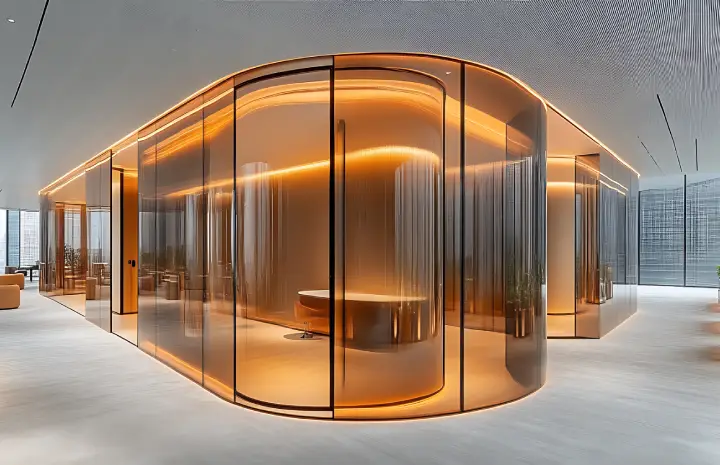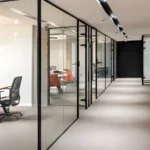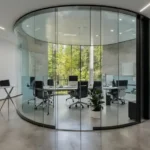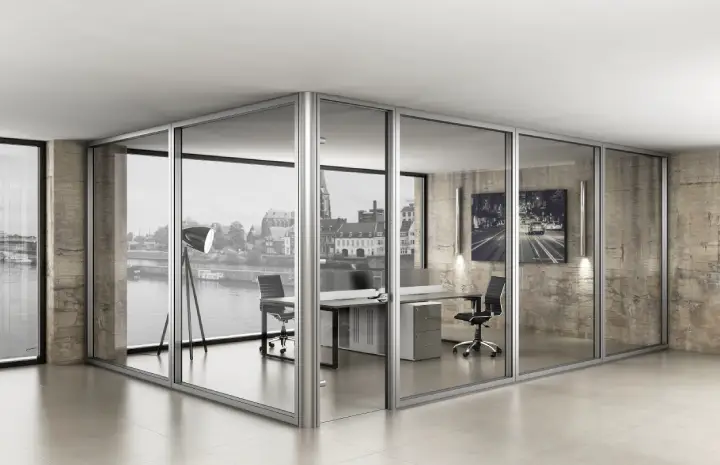Creating Fluid Office Layouts Using Curved Glass Wall Systems
Modern office design has evolved beyond rigid cubicles and enclosed rooms. Today’s workspaces focus on openness, collaboration, and aesthetics — and few design elements achieve this better than curved glass wall systems. They blend transparency with creativity, allowing light to flow naturally while introducing soft, elegant shapes that redefine how an office feels and functions.
In the era of flexible working environments, curved glass has become a powerful architectural solution for offices seeking a balance between openness and privacy. Let’s explore how these innovative wall systems create fluid layouts and enhance both productivity and design.
The Concept of Fluid Office Design
Fluid office design is about more than just aesthetics. It emphasizes continuous movement, flexible zones, and visual connectivity across the workspace. Instead of sharp corners or boxed layouts, smooth transitions between departments and teams foster communication and creativity.
Curved glass wall systems play a central role in this concept. Their seamless flow and transparent appearance make spaces feel larger, lighter, and more connected — without sacrificing structure or acoustic control.
These systems encourage visual openness, allowing teams to feel part of a unified environment while still maintaining their own defined work zones. The result is an office that feels dynamic, welcoming, and efficiently organized.
Why Choose Curved Glass Wall Systems for Modern Offices
- Enhanced Visual Flow
Straight partitions often create harsh separations that disrupt movement. Curved designs, on the other hand, lead the eye smoothly through the space. This natural flow makes the office appear more spacious and aesthetically balanced. - Improved Natural Lighting
Glass naturally invites light into interior areas that would otherwise rely on artificial illumination. With curved glass wall systems, light travels gracefully across different sections of the workspace, reducing shadows and dark corners. This not only brightens the environment but also boosts mood and productivity. - Design Flexibility and Aesthetic Appeal
Curved glass partitions can adapt to any office layout — from meeting pods and reception areas to private offices and corridors. They add architectural interest and sophistication, transforming a simple workspace into a visually stunning environment. - Defined Yet Connected Spaces
These partitions create clear divisions without the feeling of isolation. Employees can see through boundaries, maintaining a sense of togetherness while reducing distractions and maintaining focus. - Acoustic and Thermal Benefits
High-quality curved glass wall systems often feature acoustic glazing that minimizes noise transfer. They also help with temperature control, keeping workspaces comfortable throughout the day.
How Curved Glass Enhances Productivity and Collaboration
Open-plan offices have become the standard for modern workplaces, but complete openness can lead to noise and distraction. Curved glass provides a middle ground — a visual connection without compromising comfort.
Curves subtly guide people through space, encouraging movement and collaboration while maintaining structure. Meeting areas can be enclosed in gentle arcs rather than boxy corners, creating a more relaxed atmosphere. The organic design influences human behavior, promoting calm, focus, and communication.
Furthermore, curved glass wall systems contribute to biophilic design principles — mimicking the fluid lines found in nature. This connection to organic form can reduce stress and make employees feel more engaged and inspired.
Applications of Curved Glass Wall Systems in Offices
- Reception Areas
A curved glass wall in the reception area immediately sets a professional, inviting tone. It enhances transparency while giving a luxurious first impression to clients and visitors. - Meeting Rooms
Enclosing meeting spaces with curved glass maintains privacy while allowing natural light to flow through. It eliminates the boxed-in feeling common with solid partitions. - Executive Cabins
Using curves for executive areas adds sophistication without creating barriers. The transparent design keeps leadership connected to the team. - Collaborative Pods
Smaller discussion or brainstorming zones enclosed in curved glass wall systems promote teamwork while reducing noise in open-plan offices. - Hallways and Transition Spaces
Curves make corridors appear wider and more fluid, improving circulation and visual appeal.
Material and Design Options for Curved Glass Wall Systems
Curved glass is available in several finishes — from clear to frosted or tinted. Frosted or patterned glass adds privacy, while clear panels maintain openness. Frameless options emphasize minimalism, giving a sleek, uninterrupted appearance.
Advanced manufacturing techniques allow customization for different radii, glass thicknesses, and edge profiles. This flexibility makes curved glass wall systems suitable for everything from minimalist tech offices to luxury corporate headquarters.
Designers can also combine them with materials like aluminum, stainless steel, or wood for added texture and contrast.
Maintenance and Longevity
One of the overlooked advantages of curved glass partitions is their durability. High-quality tempered or laminated glass resists scratches and impacts, ensuring long-term clarity and performance.
Maintenance is simple — regular cleaning with a mild glass-safe cleaner keeps the surface spotless. Because these systems use fewer joints and frames, there are fewer areas for dust to accumulate, maintaining a cleaner and more professional workspace.
Sustainability Advantages
Sustainability is now a key factor in modern office design. Curved glass wall systems contribute to greener buildings by maximizing natural light, reducing reliance on artificial lighting, and improving energy efficiency.
Additionally, glass is a recyclable material, and many systems use eco-friendly production methods. By choosing energy-efficient glazing, businesses can also minimize heat transfer, contributing to reduced HVAC energy use.
The Future of Office Design with Curved Glass
As workplaces continue to evolve, flexibility and visual harmony are becoming top design priorities. Curved glass will play a major role in shaping these spaces — blending architectural creativity with function.
Future offices will favor adaptable layouts where partitions can be reconfigured easily. The smooth, flowing nature of curved glass wall systems makes them ideal for modular and scalable interior solutions that can evolve with business needs.
Beyond aesthetics, these partitions promote wellness, communication, and transparency — values that define successful modern organizations.
Conclusion
Curved glass has moved from being an architectural statement to a practical design solution that redefines how we view workspace interiors. It bridges the gap between privacy and openness, structure and freedom, elegance and efficiency.
By integrating curved glass wall systems into office layouts, businesses can create spaces that feel cohesive, inspiring, and future-ready. The result is a workplace that not only looks stunning but also supports the flow of light, energy, and collaboration across every corner.




